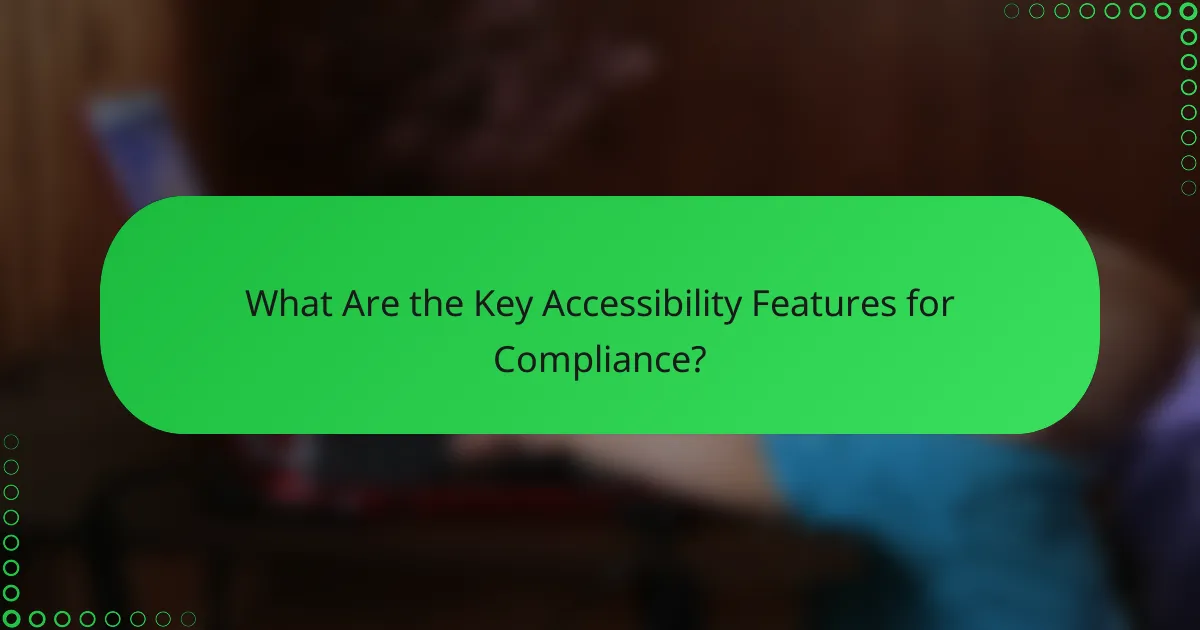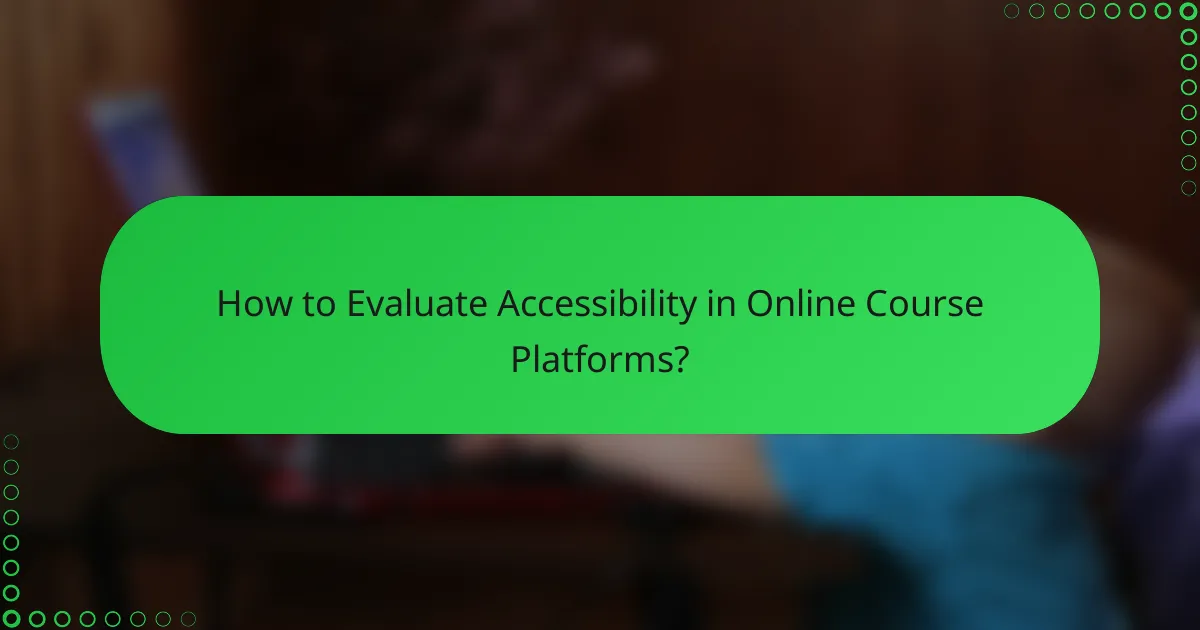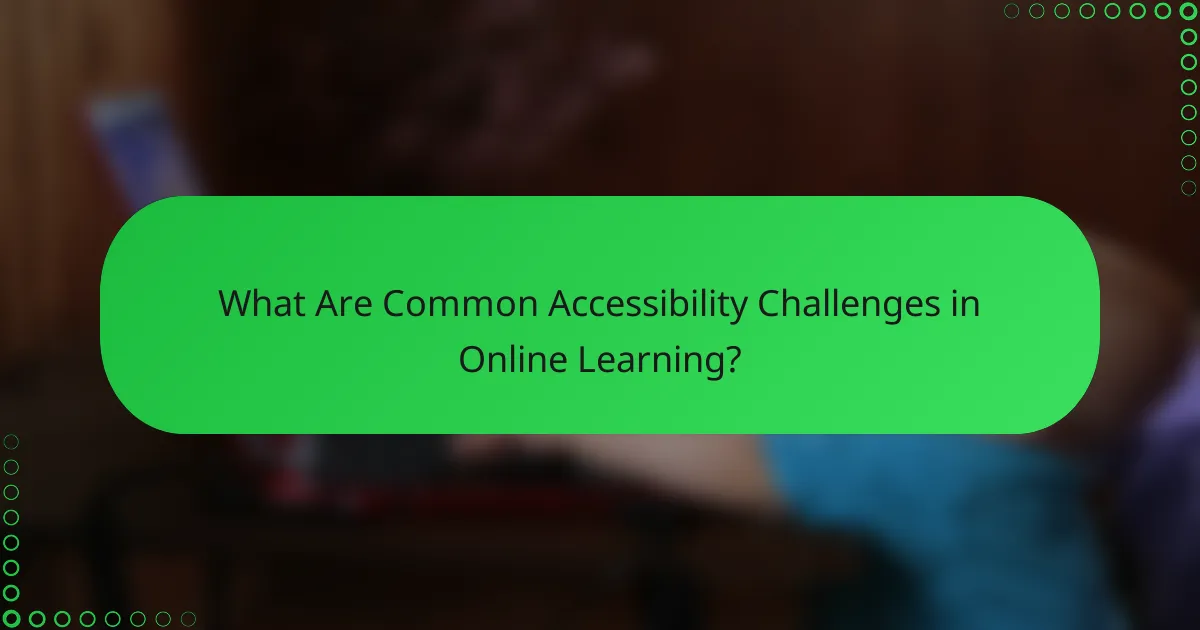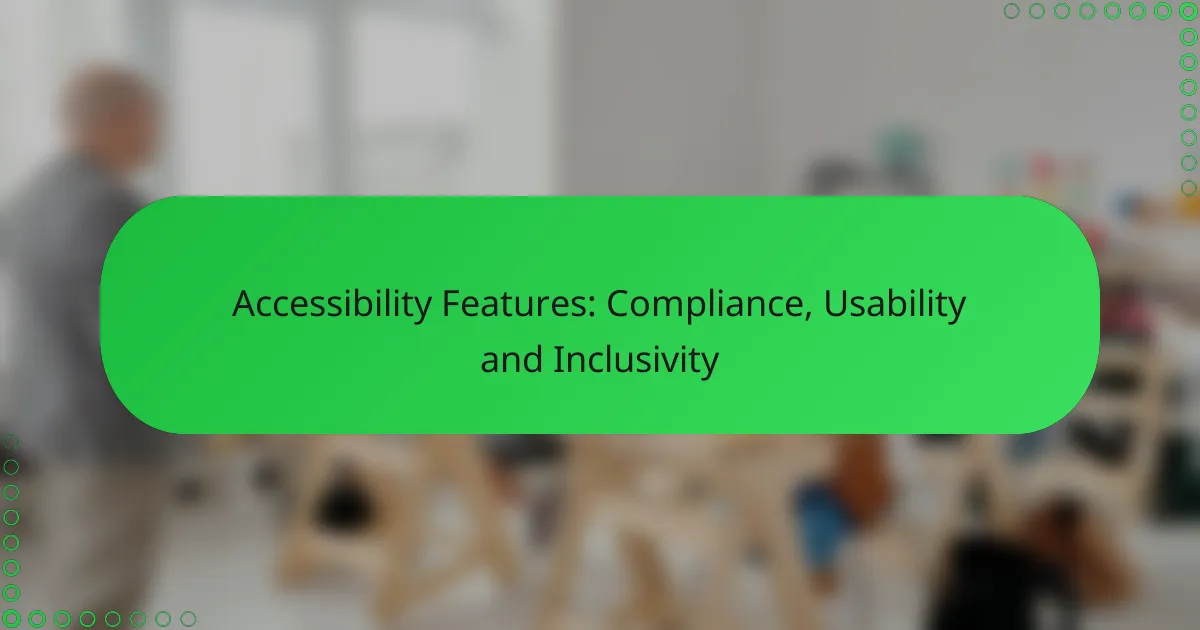Accessibility features play a crucial role in ensuring that digital content is compliant with legal standards while enhancing usability for all users, particularly those with disabilities. By implementing these features, organizations not only meet regulatory requirements but also create a more inclusive environment that allows everyone to access information and services effectively, which is essential for improving the overall cloud streaming user experience.

What Are the Key Accessibility Features for Compliance?
Key accessibility features for compliance ensure that digital content is usable by individuals with disabilities. These features help organizations meet legal requirements and enhance user experience by making information accessible to everyone.
Web Content Accessibility Guidelines (WCAG)
The Web Content Accessibility Guidelines (WCAG) provide a comprehensive framework for making web content more accessible. These guidelines are organized around four principles: perceivable, operable, understandable, and robust, often referred to as POUR.
To comply with WCAG, websites should implement features such as text alternatives for non-text content, keyboard navigability, and sufficient contrast between text and background. Regular audits and user testing with individuals who have disabilities can help identify areas for improvement.
Section 508 Compliance
Section 508 requires federal agencies in the United States to ensure that their electronic and information technology is accessible to people with disabilities. This includes websites, software, and electronic documents.
To achieve Section 508 compliance, organizations must follow specific technical standards, such as providing accessible forms and ensuring compatibility with assistive technologies. Regular training for staff on accessibility practices can help maintain compliance and improve usability.
ADA Standards for Accessible Design
The Americans with Disabilities Act (ADA) sets standards for accessible design, which apply to public accommodations and commercial facilities. These standards aim to eliminate barriers that prevent individuals with disabilities from accessing services and information.
To comply with ADA standards, businesses should ensure that their websites are navigable and usable for individuals with disabilities. This may include features like screen reader compatibility and the use of accessible design principles. Regularly updating content and design in line with ADA requirements can help avoid legal challenges and enhance customer satisfaction.

How Do Accessibility Features Enhance Usability?
Accessibility features significantly enhance usability by making digital content easier to navigate and interact with for all users, particularly those with disabilities. These features ensure that websites and applications are inclusive, allowing everyone to access information and services effectively.
Improved Navigation
Improved navigation is crucial for enhancing usability, as it allows users to find information quickly and efficiently. Features like clear headings, breadcrumb trails, and consistent layouts help users understand their location within a site and how to move through it.
To optimize navigation, consider implementing a logical structure with intuitive menus and search functionality. Avoid cluttering pages with excessive links, as this can overwhelm users. Instead, prioritize essential links and use descriptive labels to guide users effectively.
Screen Reader Compatibility
Screen reader compatibility is vital for users who rely on assistive technologies to access content. Properly tagged HTML elements, such as headings, lists, and images with alt text, ensure that screen readers can convey the information accurately.
To enhance compatibility, follow the Web Content Accessibility Guidelines (WCAG) recommendations. Regularly test your site with popular screen readers like JAWS or NVDA to identify and fix any issues that may hinder usability for visually impaired users.
Keyboard Navigation
Keyboard navigation allows users to interact with a website without a mouse, which is essential for individuals with mobility impairments. Ensuring that all interactive elements are accessible via keyboard shortcuts can significantly improve the user experience.
To implement effective keyboard navigation, use the Tab key to navigate through links and form fields. Provide visual focus indicators to show which element is currently selected. Regularly test your site to ensure that all features are operable using only a keyboard, avoiding reliance on mouse actions.

What Are the Benefits of Inclusivity in Online Courses?
Inclusivity in online courses enhances the learning experience for all students, making education more accessible and effective. By accommodating diverse needs, courses can foster a more engaging and supportive environment that benefits both learners and educators.
Wider Audience Reach
Creating inclusive online courses allows institutions to attract a broader audience, including individuals with disabilities, non-native speakers, and those from various cultural backgrounds. This expanded reach can lead to increased enrollment and participation rates, as more learners feel welcomed and valued.
To effectively widen your audience, consider implementing features such as captioning for videos, alternative text for images, and multilingual support. These enhancements can significantly improve accessibility and engagement for diverse learners.
Enhanced Learning Outcomes
Inclusivity directly contributes to improved learning outcomes by addressing the varied needs of students. When courses are designed with accessibility in mind, learners can better engage with the material, leading to higher retention and comprehension rates.
Utilizing diverse teaching methods, such as interactive content and flexible assessment options, can cater to different learning styles. This approach not only supports students with disabilities but also benefits all learners by providing multiple pathways to understanding.
Positive Brand Reputation
Institutions that prioritize inclusivity in their online courses often enjoy a stronger brand reputation. By demonstrating a commitment to accessibility and diversity, organizations can build trust and loyalty among current and prospective students.
To enhance your brand reputation, actively promote your inclusive practices through marketing materials and social media. Highlighting success stories from diverse learners can showcase your dedication to creating an equitable learning environment.

How to Evaluate Accessibility in Online Course Platforms?
Evaluating accessibility in online course platforms involves assessing their usability for individuals with disabilities. Key factors include the availability of assistive technologies, user interface design, and compliance with established accessibility standards.
Accessibility Testing Tools
Accessibility testing tools help identify barriers that may hinder users with disabilities from effectively engaging with online courses. Popular tools include WAVE, Axe, and Lighthouse, which can analyze web pages for compliance with the Web Content Accessibility Guidelines (WCAG).
When using these tools, focus on critical areas such as keyboard navigation, color contrast, and screen reader compatibility. Regular testing during the development phase can significantly enhance the user experience for all learners.
User Feedback Mechanisms
User feedback mechanisms are essential for understanding how real users interact with online course platforms. Surveys, usability testing sessions, and direct feedback forms can provide insights into accessibility challenges faced by learners.
Encourage users to share their experiences and suggestions for improvement. Implementing changes based on this feedback can lead to a more inclusive learning environment, ultimately benefiting a wider audience.
Compliance Checklists
Compliance checklists serve as practical guides to ensure that online course platforms meet accessibility standards. These checklists typically include criteria based on WCAG, Section 508, and other relevant regulations.
Key items to include are text alternatives for non-text content, navigable interfaces, and sufficient contrast ratios. Regularly reviewing and updating the checklist can help maintain compliance and improve overall accessibility.

What Are the Best Practices for Designing Accessible Online Courses?
Designing accessible online courses involves implementing strategies that ensure all learners, including those with disabilities, can effectively engage with the content. Key practices include using descriptive alt text for images, maintaining clear layouts, and adhering to color contrast guidelines.
Use of Alt Text for Images
Alt text is essential for making images understandable to users who rely on screen readers. It should provide a concise description of the image’s content and purpose, typically no longer than a couple of sentences.
When creating alt text, avoid phrases like “image of” or “picture of” and focus on the image’s function. For example, instead of saying “image of a dog,” you might say “a golden retriever playing fetch.” This approach enhances comprehension for visually impaired users.
Clear and Consistent Layouts
A clear and consistent layout helps all users navigate online courses more easily. Use headings, subheadings, and bullet points to organize information logically, making it easier to scan and understand.
Ensure that the same layout is applied throughout the course. For instance, if you use a specific format for quizzes, maintain that format across all quizzes to avoid confusion. This consistency can significantly improve the user experience.
Color Contrast Guidelines
Color contrast is critical for readability, especially for users with visual impairments. Text should have a contrast ratio of at least 4.5:1 against its background to ensure it is legible for most users.
When selecting colors, consider using online tools that evaluate contrast ratios. Avoid relying solely on color to convey information; instead, combine color with text labels or patterns to enhance clarity. For example, use both red text and an icon to indicate errors in a form.

What Are Common Accessibility Challenges in Online Learning?
Common accessibility challenges in online learning include lack of awareness, inadequate resources, and technological barriers that hinder effective participation for all learners. These issues can significantly impact the usability and inclusivity of educational platforms, making it essential to address them for a more equitable learning environment.
Lack of Awareness
A significant challenge in online learning is the lack of awareness regarding accessibility needs among educators and institutions. Many instructors may not recognize the specific requirements of students with disabilities, leading to unintentional exclusion.
To combat this, training programs should be implemented to educate staff about accessibility standards and best practices. Regular workshops can help raise awareness and foster a more inclusive mindset within educational organizations.
Inadequate Resources
Inadequate resources often limit the ability of institutions to provide accessible online learning experiences. This can include insufficient funding for accessibility tools or a lack of expertise in creating accessible content.
Institutions should prioritize budgeting for accessibility features, such as screen readers, captioning services, and alternative formats for course materials. Collaborating with organizations that specialize in accessibility can also help bridge resource gaps.
Technological Barriers
Technological barriers present a significant obstacle in online learning, as not all platforms are designed with accessibility in mind. Issues such as incompatible software, poor website navigation, and lack of mobile optimization can hinder access for students with disabilities.
To improve accessibility, institutions should evaluate their online learning platforms against established guidelines like the Web Content Accessibility Guidelines (WCAG). Regular testing with assistive technologies can help identify and rectify barriers, ensuring a smoother experience for all users.
